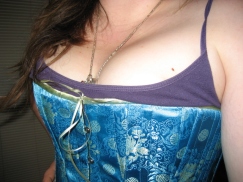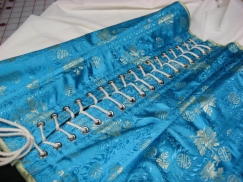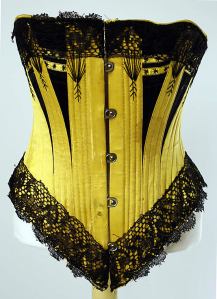(The 18/19c Bumpad)
While planning for my quick and dirty Dickens costume, I piled “petticoats” onto my dummy, attempting to achieve some sort of vague fullness. I quickly realized that my sadly narrow skirts just weren’t going to cut it. I also couldn’t find my oddly stiff 360++ degree original faire skirt that I was considering starching into service. I tried cheating by adding a mid-length 50s tulle underskirt. That did add some volume, except the shape deflated from waist to hip and below the knee. Clearly I needed more volume! And in the right shape. This was an era of maximum fullness in skirts. I’m not portraying an upper class lady, but I reason that even most working women would aspire toward fashionable fullness when they go out on the town, to High Tea and whatnot.

Two petticoats, cheater tulle and a faire skirt standing in for the yet-to-be-made top skirt. What sad shape with fullness only in the middle third.
I researched the easiest way to get volume under my 1860 skirt and came across the American Duchess post about her unconventional underpinnings. I too find myself a bit lazy when it comes to underpinnings, impatient if you will. Her comments about always using a Bumpad and the “Ugly Puffer” seemed like an excellent place to start. I thought I’d make the bumpad, use the tulle, and add a 14″ flounce to the bottom of a tiered petticoat, for extra fullness (meaning I needed about 7y x 15″). The Ugly Puffer wouldn’t be necessary, surely?
I first tackled the Bumpad. Using the three section idea from American Duchess and the shape of one on the Laughing Moon #112 Bustles and Hoops pattern, but making it like 8 sizes bigger, I got to work. My materials were a remnant of white dotted cotton, some grograin ribbon, stuffing and a zipper, all from my stash. I didn’t know how much to stuff the bumpad, so I decided the best plan was to make it changeable. Hence the zip.
Only being a two piece item, the Bumpad came together easily. I hadn’t done a zip in ages and managed to leave the top and bottom bits a little outside the seam. Meh. Only I’ll see (#lazysewing). Once stitched together and tried on, I made some stuffing adjustments, took the stuffing out, stitched the seams for the sections and restuffed it. Accomplishment! (Sometimes it’s the little things).

The waist could have been more curved. I hadn’t stitched the sections yet in this pic.

Dummy is now wearing my late Victorian waist cincher (Laughing Moon pattern) and the Bumpad. I don’t have a full corset and am not making one this go-round.

The more full petticoat, Bumpad and stand-in top skirt. Not bad, but a little butt-focused and deflated at the front and sides.
Under the petticoat it did make a big difference, but it was bustle-like and the petticoats still lacked the right fullness. The tulle was already out because it didn’t fit over the bumpad. I’d been hunting up enough fabric for that huge flounce and was unhappy with my options. Perhaps I could skip that extra flounce and make my own Ugly Puffer… By making one more thing I’d have one less thing to make??? What was I getting myself into?
Next time: Bonus pocket
Later: Son of Ugly Puffer!








